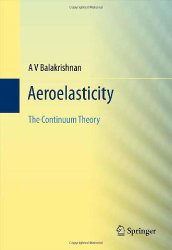Engineering Bookshelf
- Aerospace
- Biological
- Civil
- Chemical
- Environmental
- Electrical
- Materials
- Mechanical
- Petroleum
- Geoengineering
- Software

Aeroelasticity: The Continuum Theory
by AV BalakrishnanPublisher: Springer
ISBN: 1461436087
Check price @ amazon.com , amazon.ca , amazon.co.uk
Book Description
The author's approach is one of continuum models of the aerodynamic flow interacting with a flexible structure whose behavior is governed by partial differential equations. Both linear and nonlinear models are considered although much of the book is concerned with the former while keeping the latter clearly in view. A complete chapter is also devoted to nonlinear theory. The author has provided new insights into the classical inviscid aerodynamics and raises novel and interesting questions on fundamental issues that have too often been neglected or forgotten in the development of the early history of the subject. The author contrasts his approach with discrete models for the unsteady aerodynamic flow and the finite element model for the structure. Much of the aeroelasticity has been developed with applications formerly in mind because of its enormous consequences for the safety of aircraft.
Aeroelastic instabilities such as divergence and flutter and aeroelastic responses to gusts can pose a significant hazard to the aircraft and impact its performance. Yet, it is now recognized that there are many other physical phenomena that have similar characteristics ranging from flows around flexible tall buildings and long span bridges, alternate energy sources such as electric power generation by smart structures to flows internal to the human body.
Customer Reviews
By Irena Lasiecka
The book presents a rigorous exposition of the theory of aeroelasticity within the framework of the continuum theory.
Derivation of equations is based on physical principles with a judicial use of asymptotic analysis. The final product are Partial Differential Equations equations describing the interaction between the flow and the structure . The Key to the theory are boundary conditions which involve physically relevant Kutta Jankovsky boundary conditions. These are critical for the correct derivation of integral equations characterizing the aeroelastic modes.
The book centers on the analysis of flutter phenomena , potential instability and the associated aeroelastic modes. This analysis is based on a detailed study of Possio integral equation which is the center piece for the theory.
Rigorous mathematical analysis and physical-engineering relevance of the topic are the main traits of this book. The author presents a deep subject with an exceptional elegance by taking advantage of powerful mathematical tools.
Very original and unique approach to the subject. Excellent source of knowledge for graduate students entering the area and for researchers in both mathematical and engineering aspects of aeroelasticity theory.
By Franciszek Dul
New point of view on aeroelasticty treated as a mathematical discipline rather than engineering science. Mathematically rigorous and elegant, but it does not propose any new physical ideas for AE and it does not explain any old unresolved questions of AE. Very nice for mathemtically oriented aeronautics scientists, as me.